It’s not a very exciting component, but you won’t get far without a chain on your bike, unless you’ve got a belt drive or are riding a penny farthing.
While a chain has a fairly simple job, there’s a lot of tech that goes into a bike chain to ensure that it meshes perfectly with the chainrings on the crankset and the cassette sprockets at the rear, to shift smoothly when it’s needed to.
Here’s a run-down of everything you need to know about bicycle chains, including the structure of a chain, different 'speed' chains, compatibility, chain length and more. Use the links below to jump to the section you need – or read on.
What is the structure of a bicycle chain?

A chain is made up of a series of links. Most chains have alternating wide and narrow links in a pattern that repeats for the length of the chain.
Each link has two side plates, which are held together by rivets (also called pins) and a roller sits on the shoulder of the outer link. In some chains, there can be a separate bushing on either side of the roller, although these are usually absent from modern chains.
To make the chain continuous, a joining pin (sometimes called a ‘rivet’) can be pushed part-way out of a link using a chain tool then pushed back into the chain around a link from the chain’s other end.
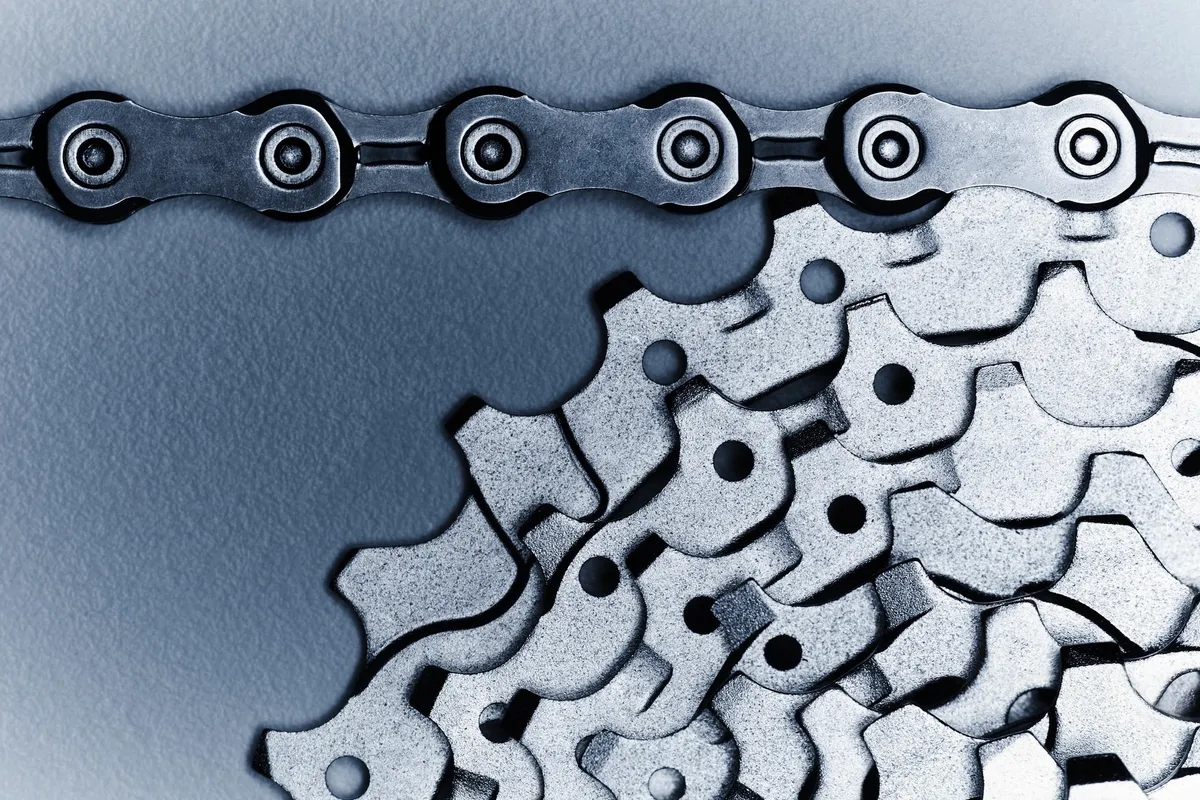
Campagnolo’s chains are joined with a bullet-shaped pin that’s longer than the chain is wide; the rounded end of the link pin is broken off (the technical term for this is ‘peened’) once the pin has been pushed into place in the chain.
As a side note, not all chain tools have a peening function for Campagnolo chains, so check yours does if you have a groupset from the Italian brand.
The other method commonly used to close the chain is to use a quick link. This comes in two halves, which push through the rivet holes in the side plates from opposite sides and mesh with each other.
They are either designed to be joined by pulling on either side of the link or to engage with each other at an angle, staying connected once the chain is straightened out.
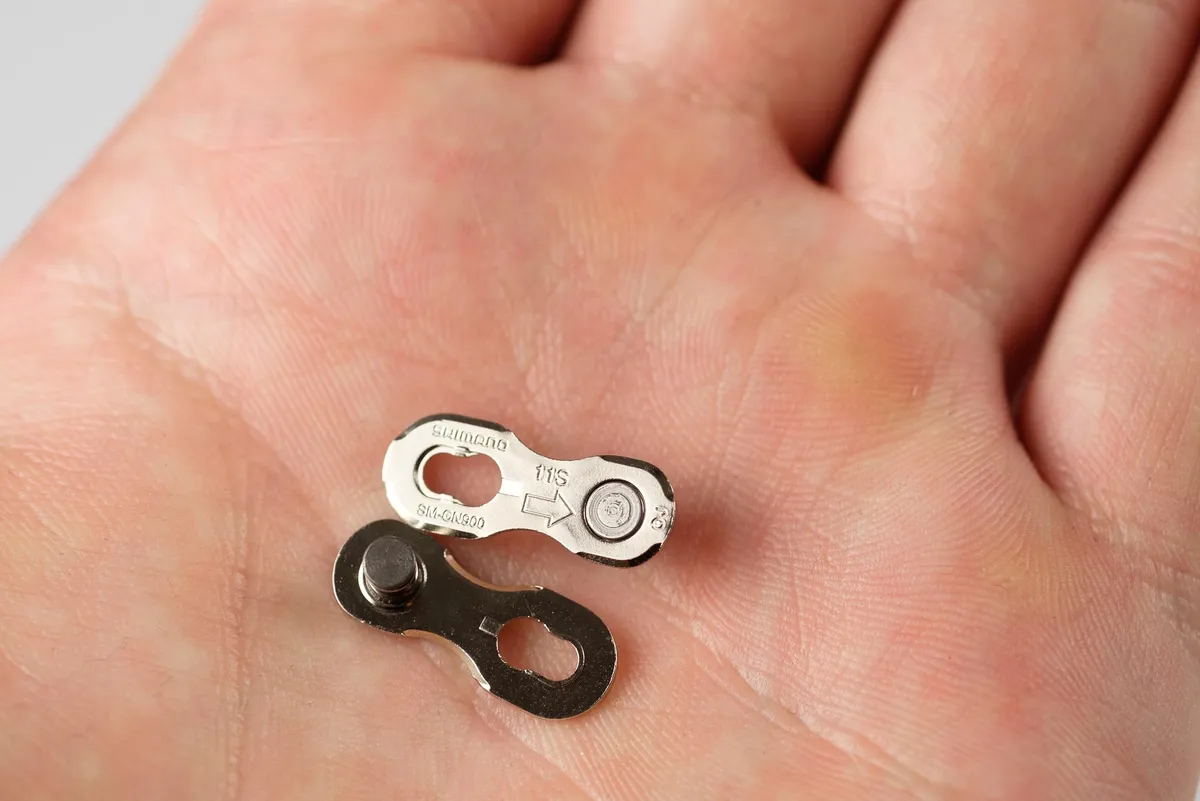
Some quick links can be separated and are reusable, whereas others, such as those used in Shimano’s and SRAM’s higher-spec chains, can’t be separated once put in place, because the quick link connection isn’t as strong the second time round.
However, some riders and mechanics reuse quick links without issue. It’s up to you if you want to take the risk.
What are the dimensions of a bicycle chain?

The standard distance between links, or pitch, of a bicycle chain is ½in (12.7mm), although there are occasional experiments with metric pitch (10mm) chains and Team GB was rumoured to be using ⅜in pitch chains on its track bikes at the Tokyo Olympics.
The inner link of a bike chain is narrower than the outer link, with a narrower space between the links. That’s used in single-ring drivetrains to ensure a robust connection between the chain and the teeth on the chainring, by having alternating wide and narrow chainring teeth.
It’s not something that can be done with a drivetrain with multiple chainrings, because the position in which the chain will land when shifted between chainrings can’t be determined, so the teeth in double and triple chainrings all have the same width, designed to mesh with the narrower inner-chain link.
It’s worth noting that the roller widths of derailleur chains for different numbers of speeds are almost the same: 2.38mm for 5- to 8-speed chains and 2.18mm for 9-speed and above. What changes is the width of the side plates.
Chain width and 'speeds'

Things get more complicated with the width side-to-side of bike chains. As component brands have increased the number of speeds in their drivetrains, they’ve added the extra gears needed in two ways: first, the freehub that holds the cassette in place on the rear wheel has been made wider.
To accommodate the extra freehub width with the same distance between the rear dropouts, that’s meant that the rear wheel has been ever-more asymmetrically dished. That’s gone about as far as it can, which is why Boost spacing has taken off in mountain bikes to even out rear-wheel geometry.
Second, cassette sprockets have got closer together and narrower. Chains have become narrower to match, which limits their compatibility between drivetrains with different numbers of gears. Therefore, you can’t run a 12-speed chain with an 11-speed sprocket set, for example, and it means that if you’ve got an 11-speed drivetrain you’ll need an 11-speed chain.
The width of chains for different numbers of gears, according to Park Tool is:
- 13 rear cogs – 4.9 mm
- 12 rear cogs – 5.3 mm
- 11 rear cogs – 5.5 mm
- 10 rear cogs – 6 mm
- 9 rear cogs – 6.5 to 7 mm
- 6, 7 and 8 rear cogs – 7 mm
You’ll see that there’s a significant variation in width.
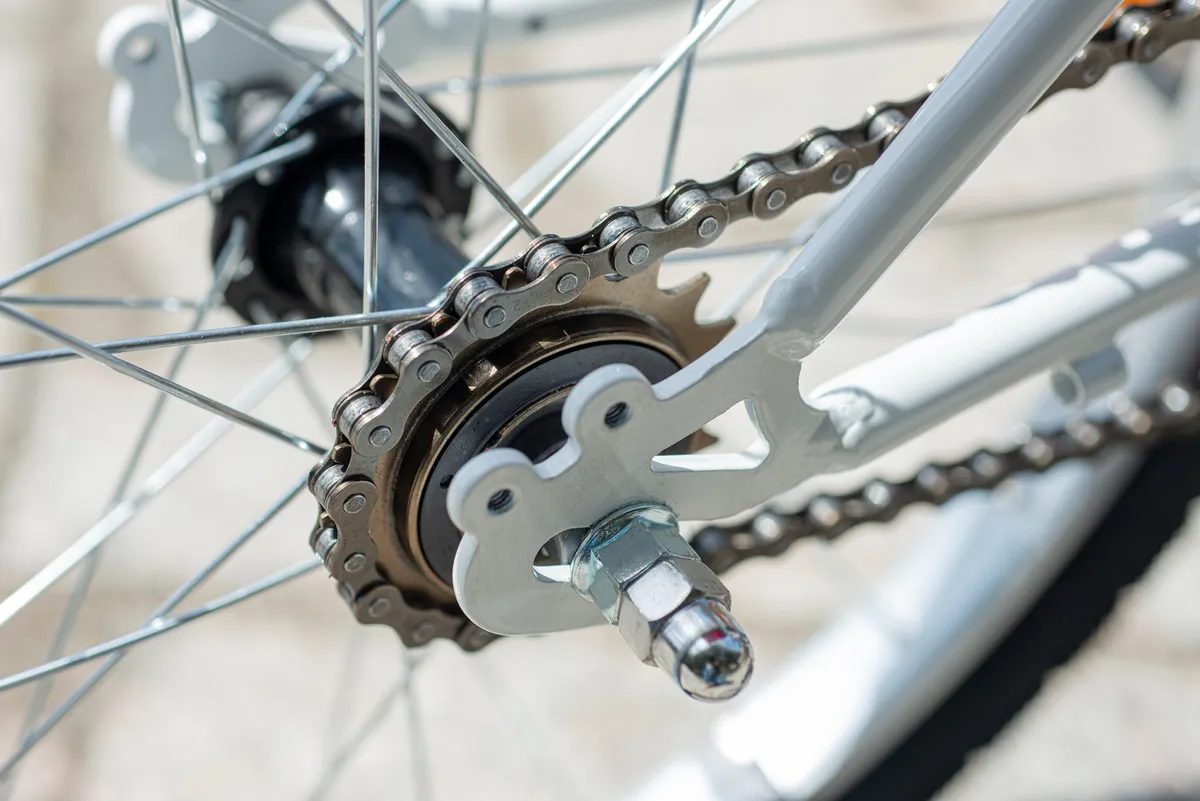
Chains for singlespeed bikes and track bikes are normally significantly wider than those designed for use with derailleur gears.
Typically, a track chain is around 9mm side-to-side. That’s partly because there’s more space for the chain at the rear hub and partly because the chain needs to be beefed up because it’s under a lot of strain both when accelerating and decelerating.
Chain compatibility
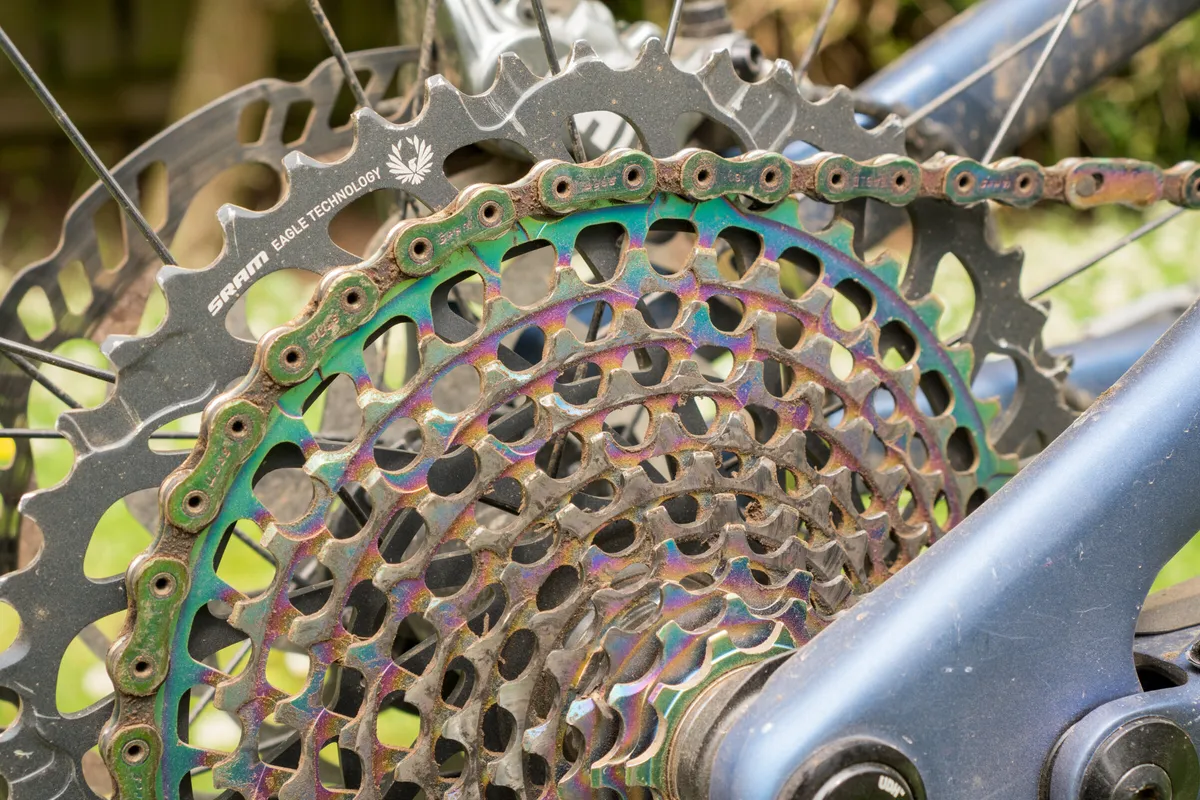
In the past, chains of the same speed could typically be mixed between manufacturers, although this is generally not the case as you head up to modern 11-, 12- and 13-speed chains, where the designs are often more specific to the brand.
For example, SRAM Eagle 12-speed chains can’t be used with 12-speed road rear derailleurs and vice versa. While you can mix some 11-speed Shimano and SRAM components, it often makes for a noisier drivetrain.
Shimano 12-speed road groupsets use the same Hyperglide+ chain as its 12-speed MTB groupsets. It has specific design features to promote faster shifting to align with the shifting ramps on the cassette.
Shimano also makes a Linkglide chain that is designed for use with electric bikes with 10 or 11 speeds, although it can be used with its Hyperglide drivetrains as well as the ebike-specific Linkglide. This has a different link shape, designed to handle the extra power provided by the electric motor.
There are brands such as Wippermann and KMC that make replacement chains that are generally compatible across all groupset makers, but it’s worth checking their sites to ensure that a specific chain is rated for your groupset.
Chain length
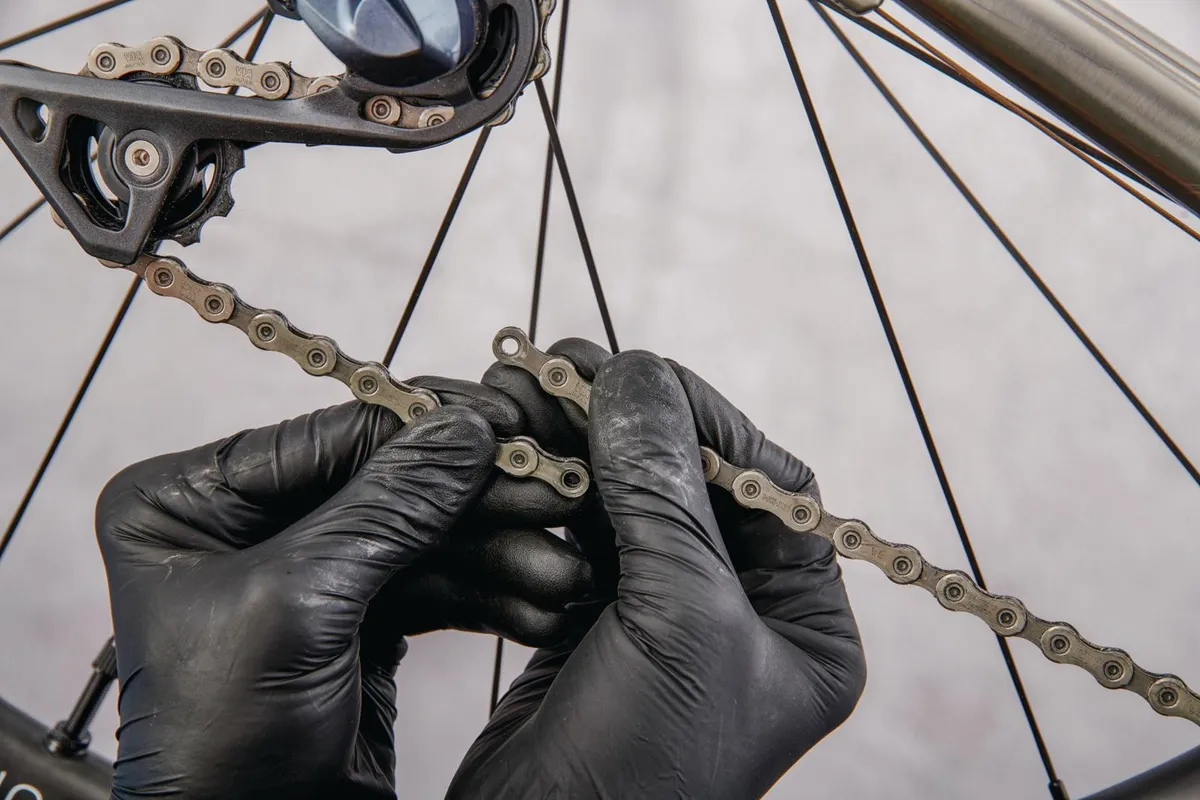
Chains are typically sold with around 110 or more links. That’s more than needed for the majority of bike applications, so the chain typically has to be reduced in length to fit on a bike.
High-pivot mountain bikes are an exception, though, which typically require a longer chain length, and you may find you need to buy two chains.
As we’ve pointed out in “How do I calculate the correct chain length?” below, the easiest way to make sure that it’s the right length is to count the number of links in your old chain and, if your old chain worked satisfactorily, replicate it in your new chain. This is on the assumption that it was cut to the correct length originally.
If you’re fitting a completely new drivetrain or altering the range of your cassette you need to be a bit more scientific and size your chain to get the correct length, as explained in our explainer on how to replace a bicycle chain.
Chain materials and construction
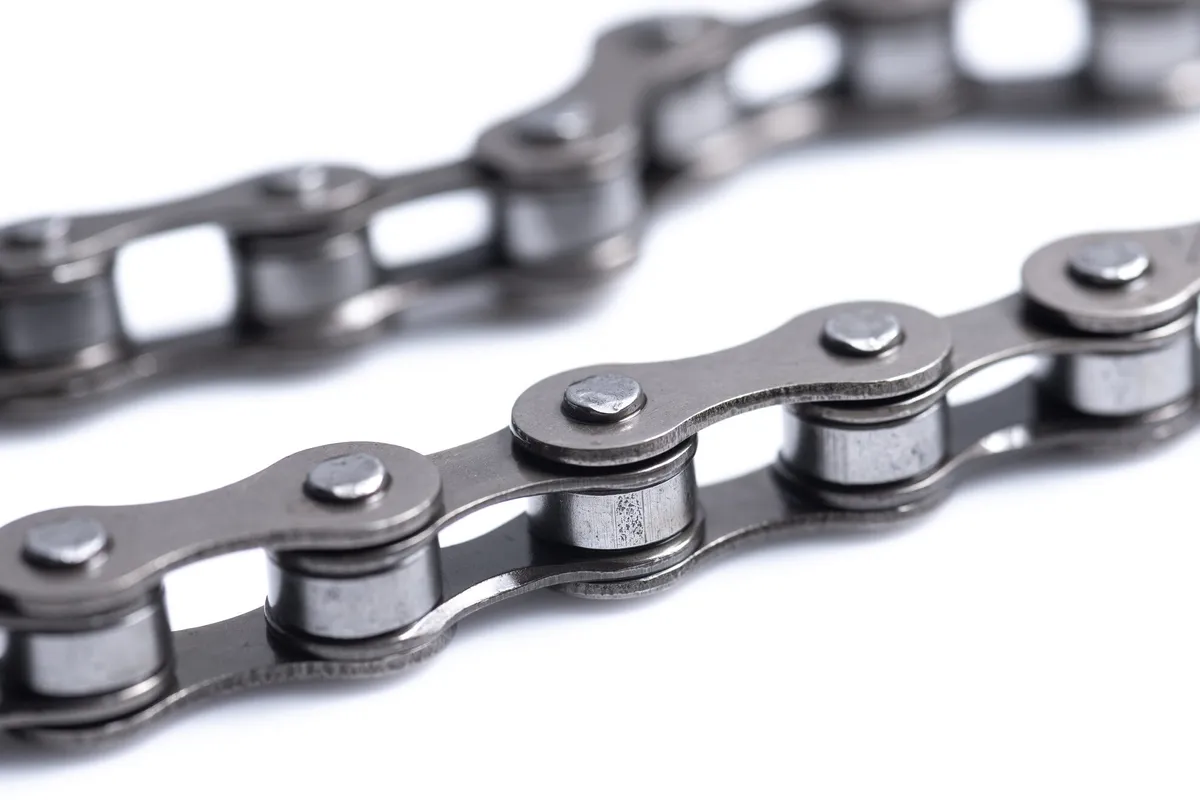
Most chains are made of steel - hence their tendency to rust if they get wet and aren’t well lubricated. Some more expensive chains have a surface treatment to help avoid rusting, improve durability, lower friction - or just to look prettier. You can also buy chains made of titanium to save a little weight.
KMC’s top-spec chains, for example, are coated with titanium carbon nitride, which KMC says lowers friction, and come with black outer plates and inner plates in a range of different colours.
The design of a chain’s outer side plates varies significantly between makes and chain models. Often, there’s some sort of ramping designed to help shifting, while more expensive chains will often have chamfered edges to the side plates rather than flat sides.
Other features of some more expensive chains include slots in the side plates and hollow pins, both designed to save weight.
Another option is a chain that is pre-treated to lower friction. Brands selling such chains include Silca and CeramicSpeed. They’re typically rated to reduce drivetrain friction for a few hundred miles’ use and possibly only in dry conditions, so they’re definitely a race-day choice.
Frequently asked questions
Are bike chains directional?
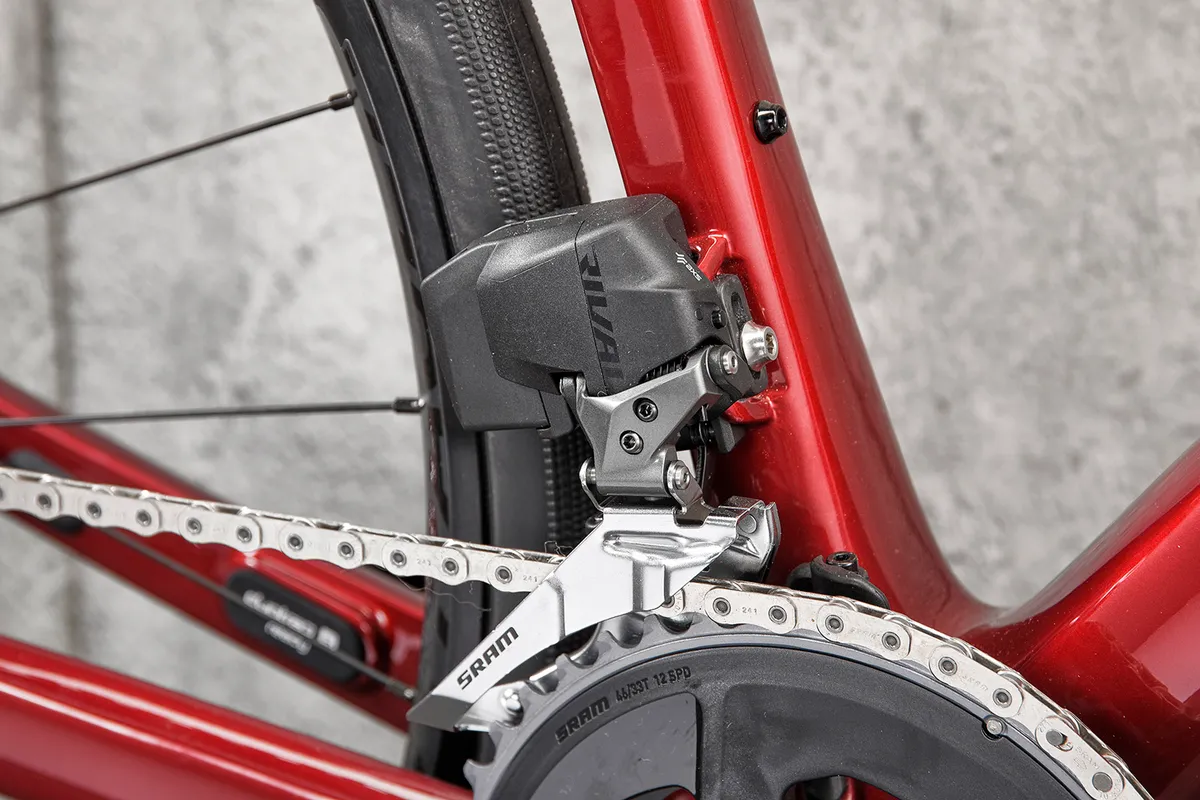
The answer is “sometimes”. Directionality depends on the brand and the groupset. Older chains for smaller numbers of gears are usually not directional. It’s when you get into more recently released chains for larger numbers of gears that some are directional.
In some cases, the outer-side links may be slotted but not the inner-side links, in which case you need to make sure they end up on the outside when you fit a new chain to your bike. In the case of SRAM’s 12-speed road chains, the flattop design means they need to be installed the right way up.
If your chain is joined together using a quick-link, it's important to check if it's directional. Some quick-links, such as Shimano’s 11- and 12-speed option, feature an arrow that points in the direction of the chain’s travel.
When should I replace a chain?
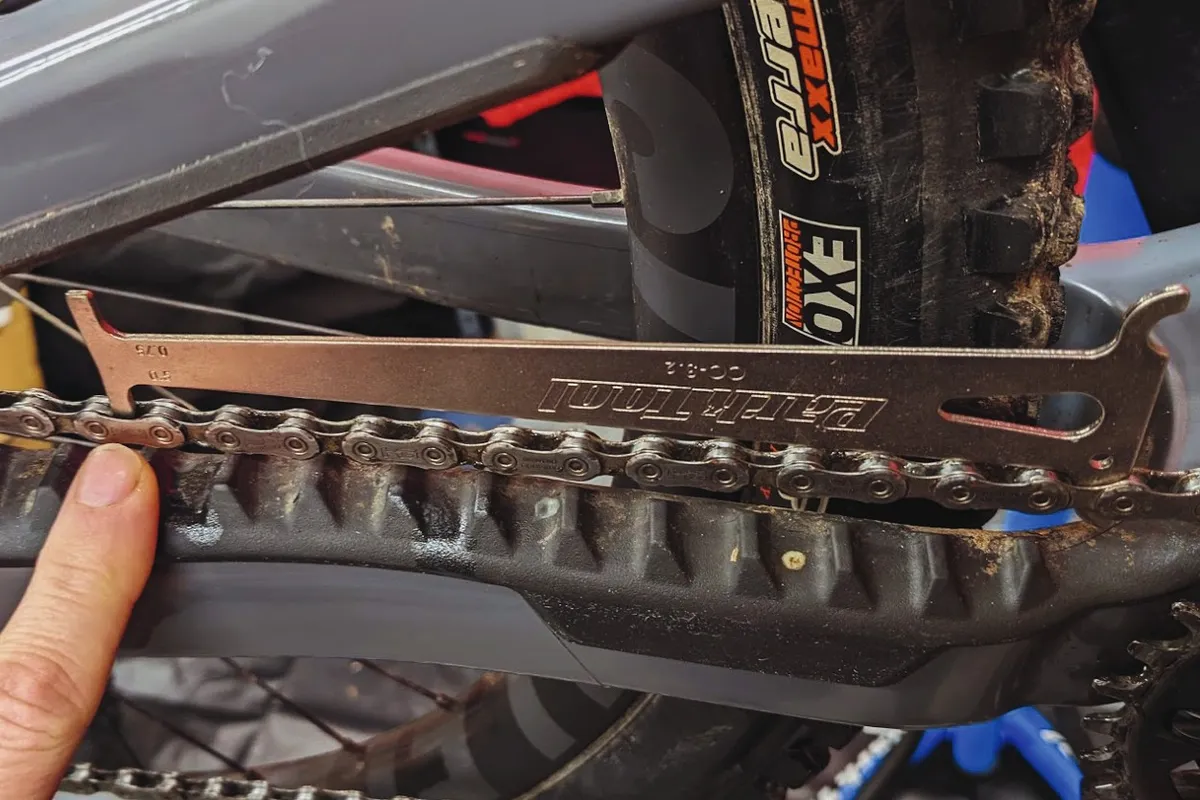
The best way to know when to replace your chain is to use a chain checker. Exactly when you need to change your chain will depend on when, how and where you ride.
As chains wear, they stretch and side-to-side movement between links will also increase. The side-to-side movement can make for sloppy shifting, while the stretch can quickly wear out cassettes and, more slowly, chainrings.
We’ve a detailed explainer on when to replace your chain, but the take-away is that an 11-13 speed chain that has stretched 0.5 per cent should be changed.

Chains that are 10-speed and under can be changed when they are at 0.75 on a chain checker because they are slightly wider.
If your 11-13 speed chain has stretched to 0.75, or your 6-10 speed chain to 1.0, you will also need to change your cassette. The rollers on the chain won’t mesh properly with the teeth on the cassette when they are worn and wear them down. If your chain has worn further, you may also need to replace your chainrings.
It is more economical to replace a chain than all three of the main components – chain, chainrings and cassette – on your drivetrain. If you change your chain once it begins to show signs of wear, you’ll likely prolong the lifetime of your cassette and chainrings.
As a rough guideline, as long as you catch the chain wear on time, you could use three chains on one cassette.
Which chain checker do I need?

You should buy a chain checker that is relevant to the number of speeds your drivetrain uses.
You can get very sophisticated examples such as the digital model from chain maker KMC and Park Tool’s CC-2 Chain Checker, but the cheapest option is a thin stamped metal tool that fits over a roller and has a point that fits between the links further up the chain.
With most chain-checking tools, if it can drop all the way into the slot between the links, your chain needs replacing. If it doesn’t, there’s still life in your chain. It’s important to check the chain in two or three locations rather than just checking in one because the chain doesn’t always stretch evenly.
Some tools, such as the Park CC4, work on a slightly different principle though, whereby you hold the gauge tip of the tool while maintaining pressure before lowering it into a link to obtain an accurate reading.
How do I know what chain to get for my bike?
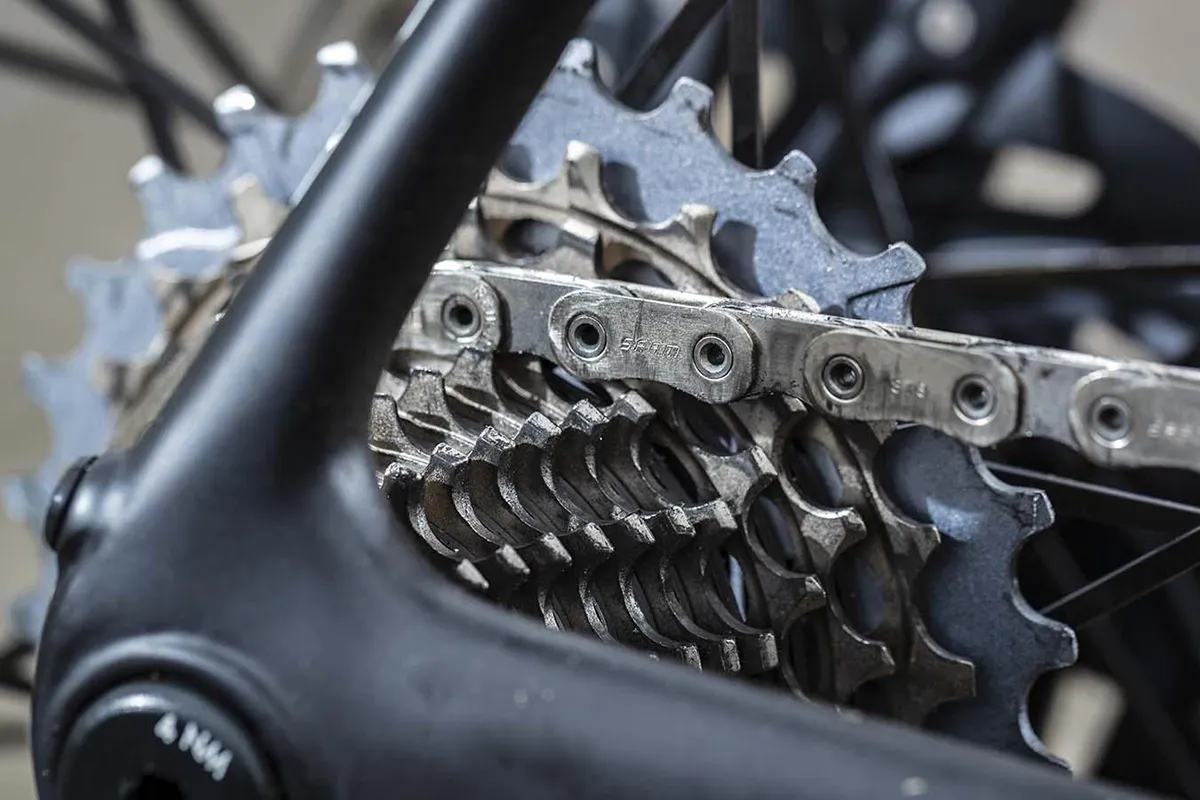
The number of cogs on the rear cassette will determine what speed chain you'll need for your bike.
Once you know what speed your drivetrain is, you'll need to find a chain that works with the corresponding number.
You can't replace an 11-speed chain with a 9-speed chain as there will be incompatibility issues due to the differing thickness of both chains.
While there is some room for interchangeability through the differing speeds, it's best to replace like with like and pick a chain designed for the number of speeds your bike has.
Sometimes you can use chains from different manufacturers, as long as they have the same number of speeds.
In some cases, you have to stick to the chain your drivetrain manufacturer provides. However many third-party companies, such as KMC, offer compatible chains for varying groupsets.
How do I replace a chain?

To replace a chain you’ll usually need a chain tool to push out a chain rivet and remove your old chain.
Having cleaned everything up thoroughly, you need to thread your new chain through the drivetrain, including the jockey wheels on the rear derailleur.
You’ll need to use the chain tool to remove the right number of links to get your chain to the correct length, then join up the two ends.
Our article on how to replace a bicycle chain has more details.
How do I calculate the correct chain length?

If you're replacing a chain the easiest way to calculate the correct length is to count the number of links in your old chain.
Measuring a chain with a tape measure won't always work because chains wear over time and grow in length.
When installing a chain on a bike for the first time, we recommend you put the chain on the largest sprocket of the cassette and the largest chainring at the front, making sure it's correctly positioned through any derailleurs.
Bringing the two ends of the chain together will give you the 'zero point'.
From here you need to decide how many links to leave in the chain.
Shimano says this depends on what kind of bike you ride and how the chain will be connected, with quick links acting as extra links.
Ridgid bikes, such as road bikes, gravel bikes, hardtails and hybrids will need 4 to 6 extra links depending on whether your chain uses a quick link or a connecting pin.
Full-suspension bikes require more slack to cope with chain pull, with Shimano recommending 5 to 7 links depending on whether your chain uses a quick link or a connecting pin.
How do I care for a chain?
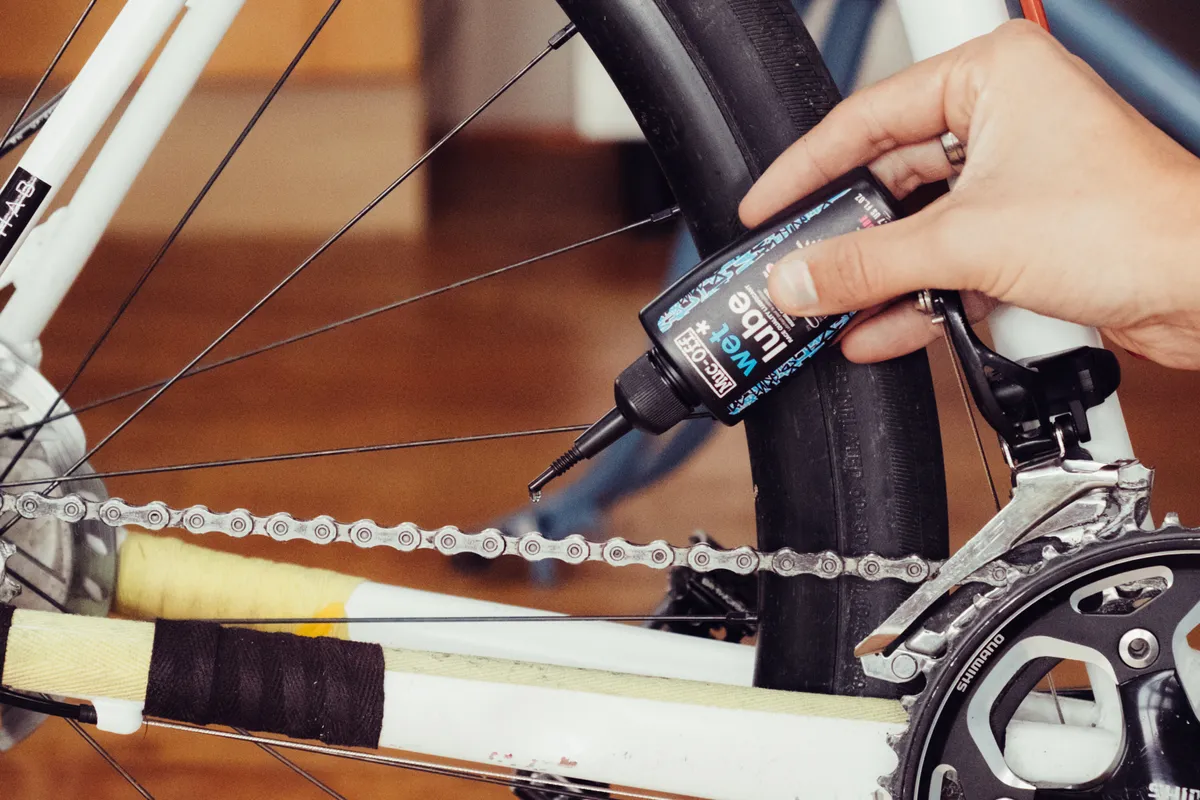
It’s important to keep your chain clean and free of contamination to reduce wear. Regular use of a chain cleaner is the best quick way to do this. After you use a chain cleaner you should dry your chain so it doesn’t rust. Then apply a thin film of chain lubricant.
Follow the chain lube maker’s instructions, but to lube your chain you should pedal the chain 10 to 20 revolutions to allow the lubricant to work its way into the rollers and then wipe away any excess lube.
It’s also important to re-lube your chain soon after a wet ride to prevent it from rusting, after thoroughly degreasing and cleaning it first. You shouldn’t apply chain lube to a dirty chain because all that will achieve is the chain attracting more dirt.
You can also wax your chain, and we go into detail on how to deep clean the chain and apply wax in our piece on how to wax a bike chain.
How do I clean a bicycle chain?

Cleaning your bike chain will remove the grit and grime that wears out cassettes, chainrings and jockey wheels before their time.
It also keeps your chain moving freely and improves efficiency when re-lubed.
There are many ways of cleaning a bike chain, with ultrasonic cleaners now becoming common for those looking to wax their chains.
We've outlined how to clean your bike chain in 8 simple steps, so for the best advice on cleaning your chain check out that article.




